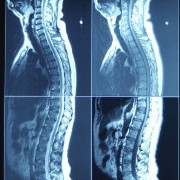Dr. Kim shares how patients with degenerative scoliosis can benefit from minimally invasive spine surgery.
Dr. Kim:
One of the most challenging problems and one of the most difficult problems that I treat is a patient with degenerative scoliosis. So this is a problem not in young children with what we call idiopathic scoliosis but in older adults as the discs degenerate. Instead of the disc collapsing straight down, they collapse in a asymmetric way, one side more than the other.
So eventually over five different levels in the lumbar spine because we have five different discs down there, if all of them start to collapse in one direction, a patient will start to develop a scoliosis over time.
Doing a scoliosis surgery on a 65-year-old where there’s a problem over multiple levels is a big deal. When we do this surgery minimally invasively, we can do the surgery that we do the same way open but through much smaller incisions. And the difference can be enormous because the traditional open surgery on a multi-level crooked spine due to degenerative scoliosis usually involves two stages of surgery with huge incisions.
Patients always go to the ICU when we do it open. They always go to a nursing home. They always have this hard shell brace that they need to wear for three months, and I can just tell you that many patients with degenerative scoliosis aren’t capable of withstanding an operation like that.
So there’s a sea of patients that have a very severe problem with a lot of pain and a lot of disability because of the difficulty standing upright or walking, but the surgery is so big open that they would rather suffer than take the risks associated with an open operation.
So when I started doing minimally invasive surgery, I started seeing a large number of patients that are 65 or 75 but otherwise very healthy, very active, that used to play tennis, used to golf, used to go on vacations, used to like to hike, and all of a sudden over the course of one to two years they can barely walk.
And their life is changed dramatically and because of the pain, the inactivity, the inability to pursue activities that bring joy in one’s life, many things are affected–their relationships, there’s a lot more depression in those patients, and if we had to do that surgery open, maybe it’s not worth the risks. It’s better to be like that, but now that we have minimally invasive surgery, many of those patients are electing to have surgeries.
Many surgeons are willing to do minimally invasive surgery on those patients, and those patients are getting a treatment that for a long time was denied to them because there was just no good option. And one of the important contributions of minimally invasive surgery is the ability to take care of a group of patients that’s clearly suffering, clearly miserable, that we had to abandon in terms of surgical treatment because we didn’t have a good treatment back then.
And now that we do minimally invasive surgery, I have a very large group of patients that fit exactly into that category, and I can tell you they are some of my happiest patients because even though the surgery is a big deal, their problem is a big deal, and if you can do this minimally invasively, it is a very worthwhile endeavor, and those are some of my happiest, the most grateful patients.
About Dr. Kim, M.D.:
Dr. Choll Kim graduated cum laude from Harvard Medical School and completed his fellowship training in complex spine surgery at the Mayo Clinic. He is board certified by American Board of Orthopaedic Surgeons.
Dr. Kim is a nationally known expert in the modern field of computer-assisted minimally invasive spine surgery. He has trained specialists throughout the country on the safe and effective application of state-of-the-art techniques using image guidance and navigation technologies.



















